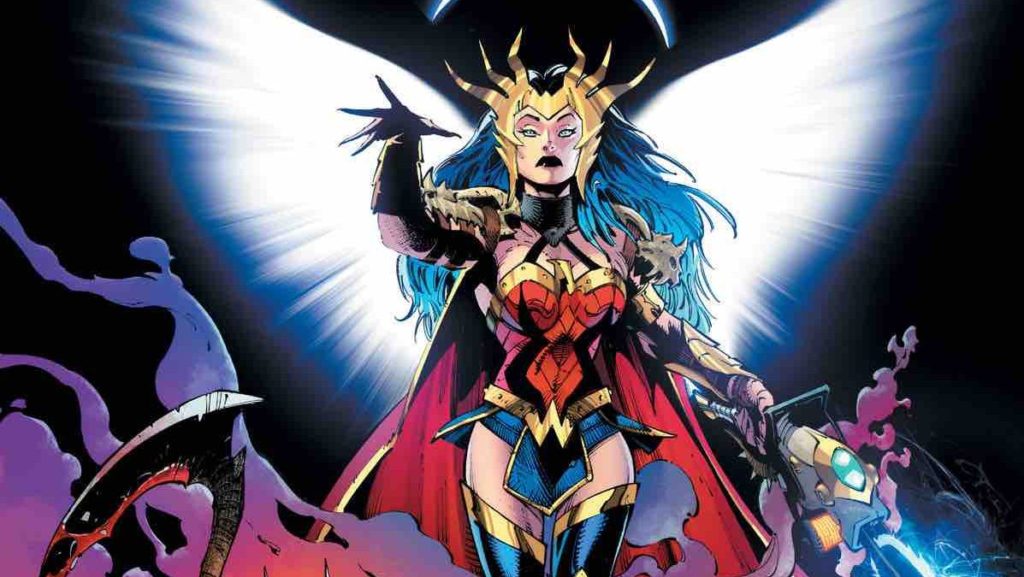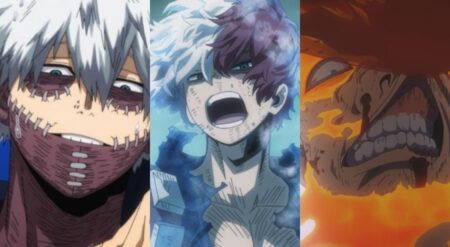
Dark Nights: Death Metal is an epic absurdity. Full stop. A t-rex with the mind of Bruce Wayne? A chainsaw of truth (we’ll talk more about that later)? But, like Dark Nights: Metal before it, this absurdity is a guise for a story packed with an intimate story, and in this one, Diana is the focus. Written by Scott Snyder, with art from Greg Capullo, inks by Jonathan Glapion, colors from FCO Plascencia, and letters by Tom Napolitano, Dark Knights: Death Metal is much more a Wonder Woman story than it is a Batman one, despite the many Bat abominations running around the surface of a destroyed world led by the Batman Who Laughs.
From the first look at the cover, I knew I was going to not only love this version of Diana but that I was going to get a story that put her power and ferocity at the front. With light coming out of her back like wings and a chainsaw in hand, Wonder Woman is the focus of issue one’s main cover. Like a Valkyrie, she brings power to every panel she’s in and beyond that, her interactions with other characters show her fierce determination to use the truth to bring back the world she lost.
Snyder explained when I spoke with him after the debut issue hit shelves that Metal and Death Metal were always two stories that were going to happen, but Death Metal is different. “What it’s really about deep down — if the first one [Metal] was really inward-looking, this one [Death Metal] is outward-looking. This one was supposed to be about how right now, everything is kind of divisive in comics. Everything is siloed and a lot of it is our fault…It’s a cacophonous thing and it was already becoming that back in 2016 [when Metal came out]. And the idea back then was to have Wonder Woman set it all straight.”
On expanding Wonder Woman’s role as the center of the Death Metal story, Snyder explains “[Wonder Woman] is saying, in a way, all of this confusion and all of this anger and dissonance between different areas in the [DC universe], whether it’s because we’ve written certain stories out or written certain ones back in, whatever it is, she’s going to come in with this chainsaw of truth and cut through that and say here is the truth: every story matters. Every person who picks up a comic book, whether its someone who picked it up today or 80 years ago is a part of an epic generational story. That’s what Death Metal is about. It’s about everything counting.”

While Diana’s attitude as the Warden of the Underworld is one part of her identity, her illustration is the other. As someone deeply affected by Wonder Woman as a hero, there are certain elements of the character that I hold on to and look for in stories where she is featured. She has to be visually powerful, towering over others with a muscular build, a testament to her warrior background. Pure strength. But that strength has to contain multitudes of character which is where vulnerability comes in.
This balance is key to a good Wonder Woman story and while Snyder’s dialogue showcases this, Capullo’s art nails it. “I saw [Capullo] when he drew her for ‘Endgame’ really struggle at first. I was like, ‘Why are these pages taking you so long?’ And he said, ‘It’s Wonder Woman.’ So I asked, ‘Well what is it about Wonder Woman,’ and he was like, ‘She has to be powerful, independent, a leader, but also vulnerable because she cares. She needs to be all of these things at once, and she can’t be sexualized.’ He added all of these things to who she was.” Snyder continued, “It gave me pause, because I said to him, I think of her as the truth. And the truth is all of these things.”
It’s this balance of strength and physical power set against emotional vulnerably and a strong moral compass that has made Wonder Woman, and more specifically Diana, a character that I see myself in. This has been especially true of stories that showcase the way people around her fear her, and yet she fights for them nonetheless.
It’s her ability to seek out the truth beyond just her lasso, that gives Wonder Woman the confidence to start saving the universe by saving one man: Batman. While she has maintained her strength and determination in Death Metal, Batman has not. He is a man riddled with guilt — in true Batman fashion — over his choices in battle. But to Diana, the path forward is just that, forward. She is there to lend her strength to those around her and push for hope.
“She has these lines that just say the things that no one would say to Batman and not in a mean way. She says them because she cares and she knows that the only way forward is through the truth and the truth is usually multifaceted,” Snyder said.
In Death Metal #2, Diana is set to rebuild the world that Batman Who Laughs destroyed, and to do so, she needs her old friend, Bruce. In the opening of the comic, she makes her way through a cemetery and winds up in a tomb face to face with a Batman who has all but given up. On the issue and Diana’s role in it, Snyder explains, “She tells Batman, who is raising an army to fight a different way than she wants to fight, ‘We can build something beautiful.’ And he says, I can’t lose again, I need to stay on the ground this time. To which she says, ‘I want you to look around Bruce because you’re not on the ground, you’re under it.’ And she doesn’t mean it figuratively, he’s not living, he’s surviving.”
Wonder Woman is the one with enough care and power to push Bruce back to who he is supposed to be. At this moment, the absurdity of the series calms and we’re presented with Diana as a peacemaker and inspiration, not the warden of the underworld and the warrior we saw in issue one. Using Alfred’s words to Bruce, she explains that bats are the only mammals that fly, an allegory for Bruce’s ability to protect others, and uses this point out that he’s no longer above the ground, but below. Snyder explains Diana’s role at this moment, “I think of her as this north star of the truth. The truth is always rough and hard, but at the same time, it’s spoken out of care. You don’t tell someone the truth unless you care.”

While there is a level of absurdity that comes with wielding a magical chainsaw as a weapon, I can firmly say that I have been waiting for a story like Dark Nights: Death Metal. I have been waiting for Diana to be showcased in both power and vulnerability. She is a woman who, like many women, must carry the burden of truth and success to overthrow and protect. Diana is fierce and that power is pushed by her refusal to give in to the despair around her. When the world quits, Diana doesn’t. She pushes past the pain and despair and uplifts those around her a chance at changing and saving the world.
In our discussion I explained the connection I have to the character, Snyder shared his personal connection to Wonder Woman as well:
“She means a lot to me because not to get too personal, but she reminds me of the women in my life. Like my wife. There have been times where I’ve been really depressed or worried or anxious or all of this, and who are the people who cut through that fog? Who are the people that remind you of what’s true in that moment? Who are the people who believe in you at times when there is very little reason to and see the truth of what you hope to accomplish or be? And who always proceeds with incredible truth in their own lives?
For me, my wife is a much better person than I am. That idea of writing someone who looks at you, looks at people, as an immortal and yet says to you: ‘It’s not about me being the hero here. It’s about me telling you that you have the potential to be a hero because I see it in you.’ Plus you knowing that it’s true. Looking at all the doubts in your head as the darkness and her lasso glowing as the light. And we’re all connected by that truth. And the truth is that all of us can be better than we are. Besides Batman, she’s the character that I’ve wanted to write the most.”
In a comic series where a monster-truck has the consciousness of Bruce Wayne this level of character study stands out and Snyder is able to provide a wondrous balance to his narrative. As Snyder said, “Death Metal, for me, is doing the Wonder Woman story I would have done in a smaller way, and hopefully, someday I’ll write her more. She’s a character that means a lot to me and this is us going all out.” Death Metal may be filled with Batmen, but its story belongs to Diana.
Dark Nights: Death Metal issues one and two are available from comic book retailers now.






![[EXCLUSIVE] ‘Invincible VS’ Devs Dive Deep Into Their New Original Character: Ella Mental Ella Mental in Invincible VS](https://butwhytho.net/wp-content/uploads/2025/12/Invincible-VS-Ella-Mental-But-Why-Tho-1-450x247.jpg)